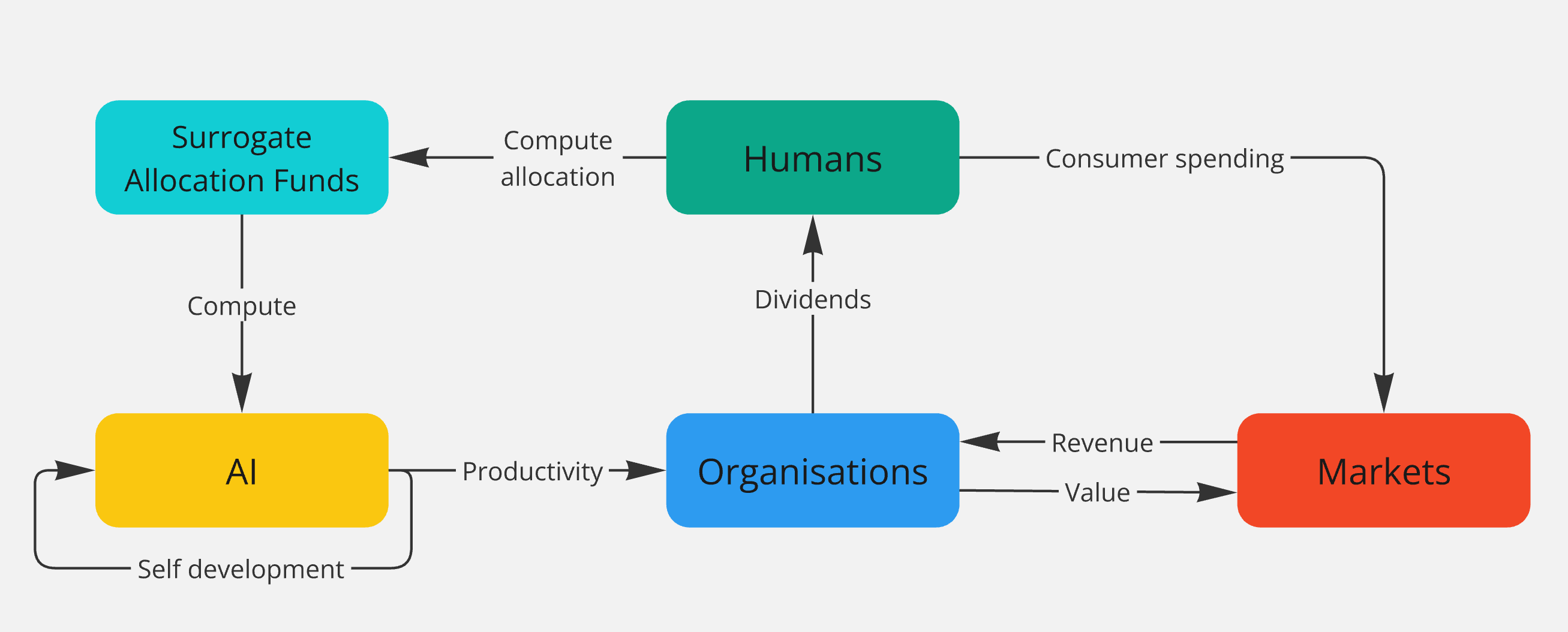
A model for the future of income and work
With AI and robotics posed to reshape industries, the very fabric of how we earn an income is at risk. As machines take on more of the workload, how do we ensure humanity thrives? Surrogate Productivity Allocation (SPA) is a proposed framework for how value is generated and distributed in a world where human contributions to productivity are increasingly unnecessary.
The problem with the current economic model
The current system is a loop between human productivity and consumption. People take part in the labour market, earning money to spend on housing, transportation, and food. The following diagram shows that loop.

In this system:
- Humans supply productivity to organisations, primarily through their labour.
- Organisations use this productivity to generate value in markets with products and services that create revenue.
- Humans earn income from the organisations they work for, which they use for consumer spending.
- This spending drives further organisational growth, completing the economic cycle.
- Humans engage in self-development to improve their standing in the labour market and increase income.
This model has worked effectively because human labour was the primary driver of economic value. However, with the prospect of AI and automation replacing most jobs, this direct link between human labour and income will break.
Proposing a model for post-AI workforce dominance
To fix this, a mechanism is required for distributing economic value and maintaining human connection to productivity. Humans allocate compute resources to AI, enabling it to act as an economic surrogate on their behalf.

In this system:
- Surrogate Productivity Funds (SPFs) manage the allocated Compute Resource Units (CRUs) on behalf of individuals. CRUs are the computational resources and productivity potential of AI systems. SPFs handle the investments and distribute dividends.
- Humans invest their CRUs through SPFs into organisations or sectors they wish to support or benefit from. Humans receive income in the form of dividends from their CRU allocations, rather than wages tied to direct labour.
- AI systems generate productivity for organisations, powered by the invested compute resources.
- Organisations use AI productivity to create value in markets, generating revenue.
- Markets function as demand-driven systems where value is exchanged, and revenue is generated.
This creates a dynamic and sustainable cycle where humans remain economically relevant as allocators of resources rather than as traditional workers.
The role of Surrogate Productivity Funds
SPFs are entities that manage the CRUs allocated to individuals. Think of them as modern equivalents to pension or investment funds, but instead of dealing with traditional financial assets, SPFs handle computational productivity.
They take on the responsibility of investing these CRUs into sectors, organisations, or industries that align with their objectives, all while tracking performance and distributing income back to individuals. For example, an SPF might allocate CRUs to a company innovating in green energy, generating income for investors while addressing climate change.
Impact
Economic stability
SPA creates a framework for income distribution in a post-labour economy. By allowing humans to continue to participate indirectly in the workforce, it ensures that economic growth benefits everyone, not just those who control capital or technology. Maintaining economic stability is critical to social stability and supporting a sustainably prosperous society well into the future.
Social equity
The universal allocation of compute guarantees that every individual has a stake in the economy, reducing the risks of marginalisation and inequality. There will be winners and losers in a system where individuals can choose how to invest their allocations. People will have the same level of opportunity in the economy.
Flexibility and adaptability
Individuals can adjust their allocations over time as industries, technologies and societal values evolve. This adaptability ensures the system remains relevant in the face of change. There is democratic power with people selecting how to allocate compute in an economy based on AI productivity.
A shift in human focus
By freeing humans from the need to engage in the labour market, they can spend time for self-development, creativity, and pursuits that enhance overall well-being. It’s difficult to predict the impact of this shift, however more people free to pursue dreams and passions increases the amount of innovative activity driving humanity forward. Increased productivity means increased prosperity and capital to invest in projects that secure and improve life for humans.
Implementation
Implementing SPA would involve several critical steps:
- Build infrastructure: Energy and data centre infrastructure is needed for the compute resources to run on.
- Defining CRUs: The allocation mechanism and amount of CRUs assigned to individuals needs to be determined to ensure fairness.
- Setting up SPFs: The governance and regulatory frameworks for SPFs needs to be set up so they operate effectively. Systems to track CRU investments, AI productivity, and revenue generation also need to be established.
- Piloting and testing: Launching in controlled environments assesses feasibility and resolves found challenges.
- Scaling: Roll out to regions and affected communities as AI expands its dominance in the workforce.
It’s difficult to predict the future or exactly how AI will change life as we know it. Surrogate productivity allocation is an option to deal with the result of human productivity becoming unnecessary as AI expands its usefulness. It’s better to aim for utopia than accept a certain dystopian future. It’s also better to start planning for this possibility before it occurs and its effects are irreversible.